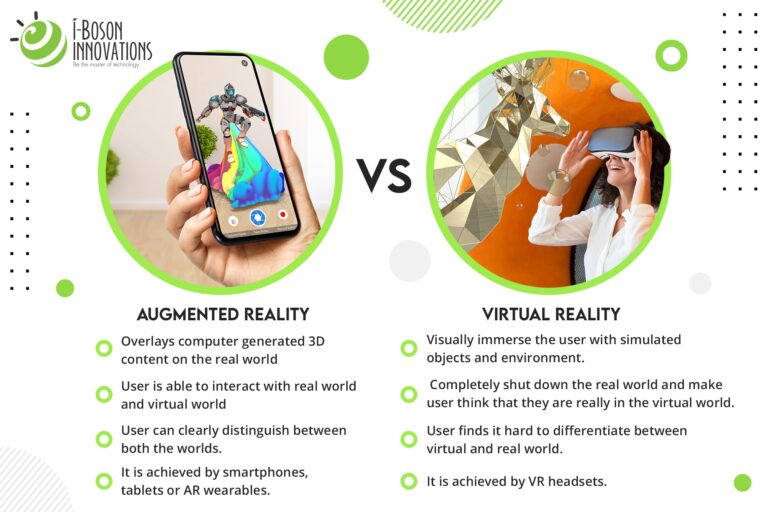As technology continues to advance rapidly, the terms “augmented reality” and “virtual reality” have become increasingly common. These two concepts may sound similar, but they are actually quite different. Augmented reality (AR) and virtual reality (VR) are both immersive technologies that have the potential to completely transform the way we interact with the world around us.
Augmented reality involves overlaying digital information onto the real world, enhancing our perception of reality. This can be achieved through the use of a smartphone camera, a headset, or other devices. Virtual reality, on the other hand, completely replaces the real world with a simulated environment. Users can interact with this environment using a headset, gloves, or other specialized equipment. In this article, we will explore the differences between AR and VR, their applications, and their potential impact on our lives.
AR and VR are similar in that they both aim to immerse the user in a virtual world. However, they differ in the way they do this. AR adds digital elements to a live view of the physical world, while VR creates a completely artificial environment. AR is typically experienced on a mobile device or through special AR glasses, while VR can be experienced through a headset.

What is the Difference Between Augmented Reality and Virtual Reality?
Augmented reality (AR) and virtual reality (VR) are two technologies that have become increasingly popular in recent years. Both technologies have their own advantages and disadvantages, and understanding the differences between them can help you make an informed decision when choosing the right technology for your project.
Differences in Use Cases
Augmented reality is used to enhance a user’s real-world experience by overlaying digital elements on top of what they see in the physical world. This can be used in a variety of settings, from gaming to education to industrial settings. In contrast, virtual reality completely immerses a user in a digitally-created environment, allowing them to explore a virtual world and interact with different objects. This makes it the ideal technology for applications such as gaming, training simulations, and virtual tours.
Differences in Technology
The technology used for augmented reality and virtual reality also differs significantly. Augmented reality typically relies on a combination of cameras, sensors, and software to track a user’s movements in the physical world and overlay digital elements. Virtual reality, on the other hand, uses specialized hardware such as a headset, controllers, and sensors to create a fully-immersive digital environment. This requires more powerful hardware and can be more expensive than augmented reality.
Differences in Cost
The cost of implementing augmented reality or virtual reality can vary significantly depending on the specific project. Augmented reality typically requires less specialized hardware, which can help keep costs down. Virtual reality, on the other hand, often requires more powerful hardware, which can drive up the cost of the project.
Differences in User Experience
The user experience for augmented reality and virtual reality also differs significantly. Augmented reality relies on the user’s existing physical environment and can be used to create a unique experience based on their location. Virtual reality, on the other hand, creates a completely immersive digital environment, allowing the user to explore a completely different world.
Differences in Applications
Augmented reality and virtual reality can be used for a variety of applications, but the specific use cases can differ significantly. Augmented reality is ideal for applications such as gaming, education, and industrial settings, while virtual reality is better suited for applications such as gaming, training simulations, and virtual tours.
Differences in Scalability
The scalability of augmented reality and virtual reality can also vary significantly. Augmented reality can be scaled to fit any application, from mobile devices to large-scale projects. Virtual reality, on the other hand, typically requires more powerful hardware, which can make it more difficult to scale up for larger projects.
Frequently Asked Questions
Augmented reality (AR) and virtual reality (VR) are two of the most popular technologies used in the entertainment and gaming industry. Both technologies have the potential to create immersive experiences, but there are key differences between the two that you should be aware of.
What is the difference between augmented reality and virtual reality?
Augmented reality is a technology that superimposes virtual objects onto the physical world. It can be used to add digital elements to a live view of the real world, such as overlays of text, images, or video. On the other hand, virtual reality is a technology that replaces the real world with a simulated environment. It immerses the user in a digital world that is completely separate from the physical world.
The main difference between augmented reality and virtual reality is that augmented reality adds digital elements to the real world, while virtual reality replaces the real world with a simulated one. Augmented reality can be used to enhance the user experience of the physical world, while virtual reality can be used to create a completely immersive experience.
In conclusion, augmented reality and virtual reality are two very different technologies, even though they both involve the use of digital elements in a physical environment. Augmented reality overlays digital elements onto the real world, while virtual reality creates a completely new environment for the user. Both technologies have their unique uses and benefits, and as the technology continues to evolve, we can expect to see even more innovative applications in various industries.
Whether it’s for entertainment, education, or business, augmented reality and virtual reality have the potential to transform the way we interact with digital content. As these technologies become more accessible and affordable, we can expect to see more widespread adoption and integration into our daily lives. Ultimately, the difference between augmented reality and virtual reality lies in the way they enhance our perception of the world around us, and the possibilities for both are endless. As we continue to explore the potential of these technologies, we can look forward to a future where the line between the digital and physical worlds becomes increasingly blurred.




